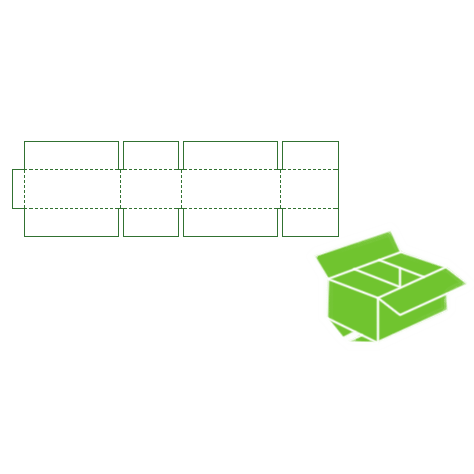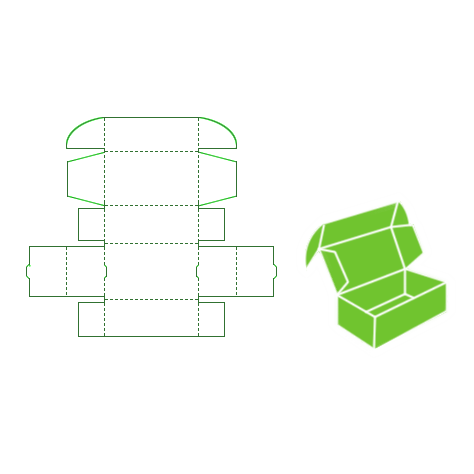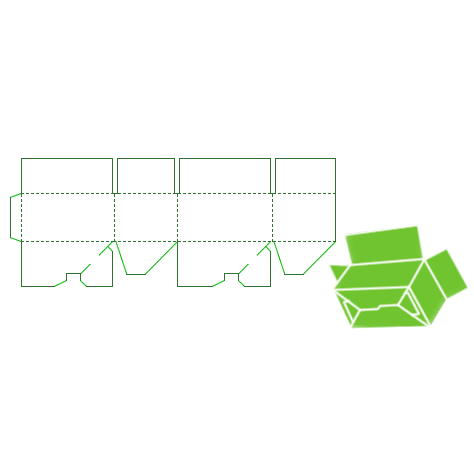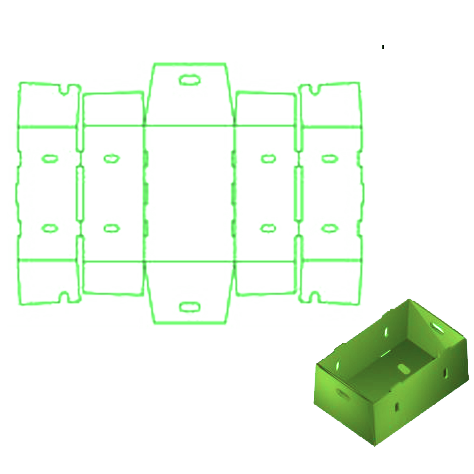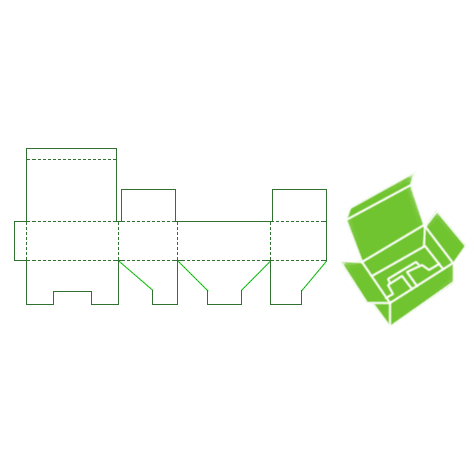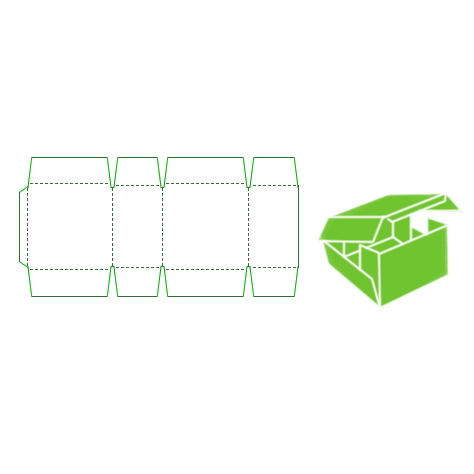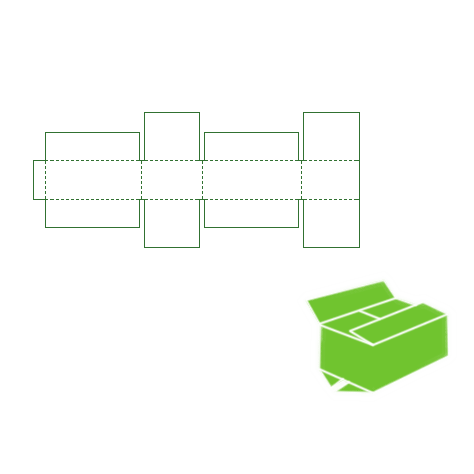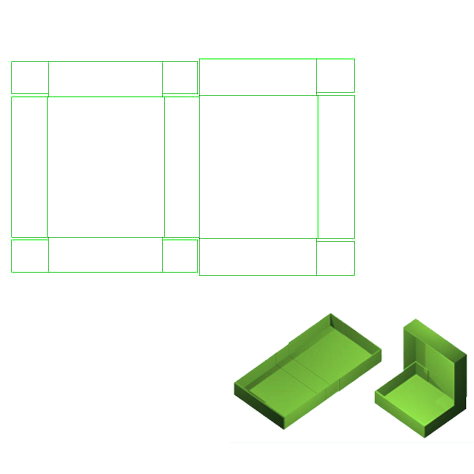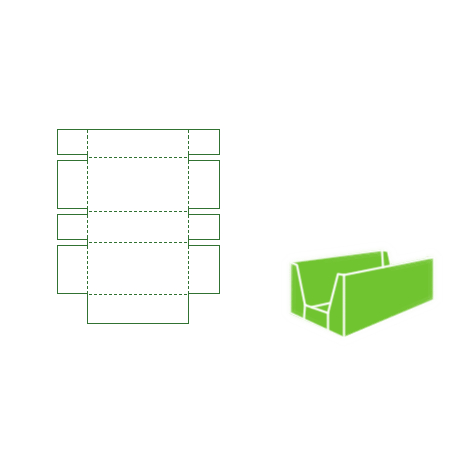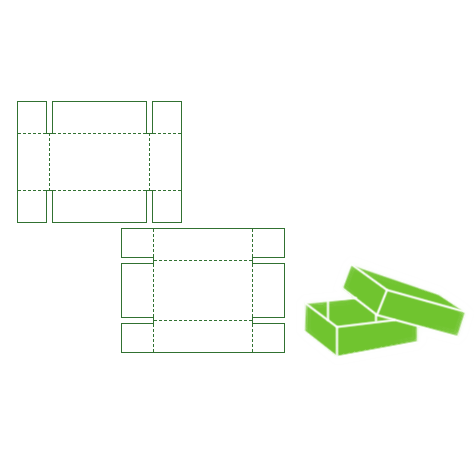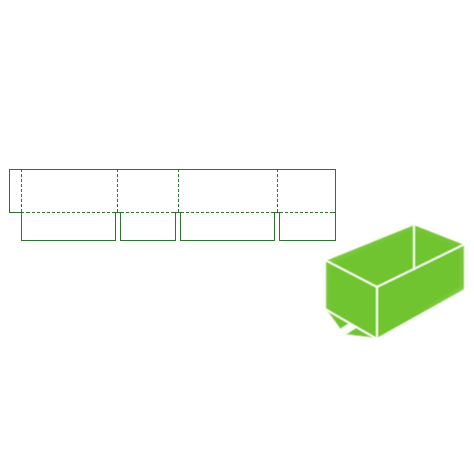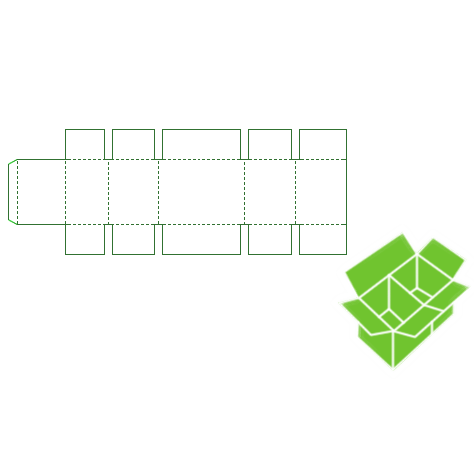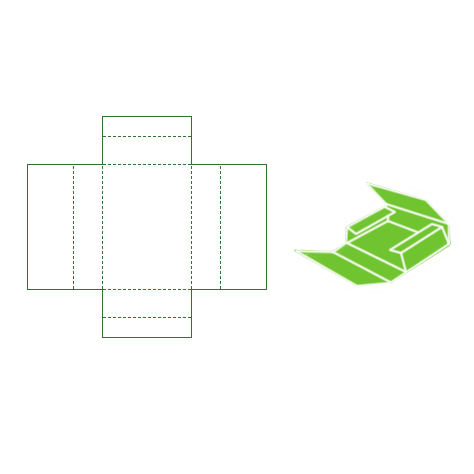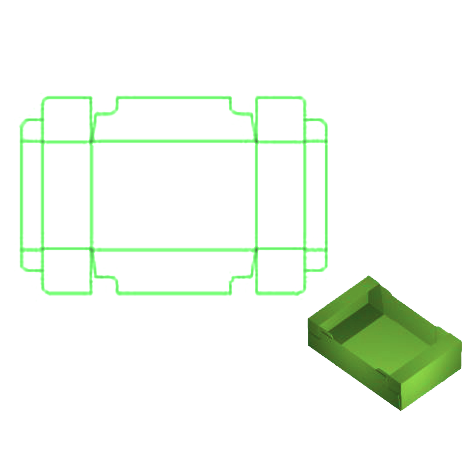A
Adhesive
Substance capable of adhering one surface to another.For fiberboard boxes,the substance is used to hold plies of solid fiber board together,to hold linerboard to the tips of flutes of corrugated medium, or to hold overlapping flaps together to form the joint or to close a box.
Anilox System
Inking system used in flexographic presses.
B
Bale
A shaped unit, usually containing compressible articles or materials, enclosed in a fiberboard container not conforming to the carriers’ rules for a box, or enclosed in other wrapping, and bound by strapping, rope or wire under tension.
Banded Unit
A package or palletized load that has a band or bands (usually plastic) applied to it.
Bar Code
An identification symbol. Alpha or alpha-numeric information is encoded in a sequence of high-contrast, rectangular bars and blank spaces. The relative widths of these bars and spaces and their sequence differentiate the individual characters that make up the encoded information. Bar codes are “read” by electronic scanners.
Basis Weight (of Containerboard)
Weight of linerboard or corrugating medium expressed in terms of pounds per 1,000 square feet (msf).
Bending
In the expression “proper bending qualities,” the ability of containerboard or combined board to be folded along score lines without rupture of the surface fibers to the point of seriously weakening the structure.
Blank or Box Blank
A flat sheet of corrugated or solid fiberboard that has been cut, slotted and scored so that, when folded along the score lines and joined, it will take the form of a box.
Bleed
To run, dilute or migrate colors into unwanted areas connected to printed areas. To print an area beyond the cut edge or score so that the design is cut off or folded under.
Board
Abbreviation for various paperboards. (See also: Boxboard, Chipboard, Combined Board, Containerboard, Corrugated Board, Fiberboard, Linerboard and Paperboard).
Box
A rigid container having closed faces and completely enclosing its contents. (See also: Fiberboard Box)
Box Manufacturer
An establishment that has equipment to score, slot, print and join corrugated or solid fiberboard sheets into boxes, and that regularly uses that equipment in the production of fiberboard boxes in commercial quantities.
Box Manufacturer’s Certificate (BMC)
A statement printed within a circular or rectangular border on a corrugated or solid fiberboard box guaranteeing that all applicable construction requirements of the carrier classifications have been observed and identifying the box manufacturer.
Box Style
Distinctive configuration of a box design, without regard to size. A name or number identifies styles in common use.
Boxboard
The types of paperboard used to manufacture folding cartons and set-up (rigid) boxes.
Built-up
Multiple layers of corrugated board glued together to form a pad of desired thickness, normally used for interior packing.
Bulk
Goods or cargo not in packages, boxes, bags or other containers; or goods unpackaged (loose) within a shipping container. Also, a large box used to contain a volume of product; e.g., “bulk box.” (See also: Loose)
Bundle
A shipping unit of two or more articles or boxes wrapped or fastened together by suitable means.
Burst Strength
The force required to rupture linerboard or combined board, using hydraulic pressure measured by a Mullen tester, relates indirectly to the box’s ability to withstand external or internal forces, and to contain the contents during rough handling. This method cannot be used on triple-wall, combined board and is of limited reliability on double-wall board, as it is difficult to force the apparatus through the multiple facings simultaneously. When using certain specifications in the carrier classifications, minimum burst strength must be certified.
C
Calender Stack
A vertically stacked set or group of heavy horizontal rollers at the end of the paper machine through which the paper web passes to densify the paper, to develop uniform caliper, and to increase smoothness.
Caliper
Thickness of a material usually expressed in thousandths of an inch (mils) or sometimes referred to as “points.”
Cardboard
A thin, stiff pasteboard, sometimes used for playing cards or signs. Misuse has extended the laymen’s definition to include boxboard (used to make folding cartons)and containerboard, a totally different material used to make corrugated board.
Carton (Folding Carton)
A folding box made from boxboard, used for consumer quantities of product. A carton is not recognized as a shipping container.
Case
A box or receptacle, or a filled box. As used by the packaging machinery industry, a corrugated or solid fiberboard box.
Case Changeover
Most pieces of packaging machinery are engineered to accommodate several case sizes. Adjusting the various machine settings to allow for a smaller or larger case is called case changeover. With most machines today, the case change-over process happens in a matter of minutes, and requires few, if any, tools.
Case Turner
When the need arises to rotate a given case from the position in which it is erected to another position, a case turner is required. Case turners range in complexity from something as simple as an angled rod to something more complicated, depending on the requirements of the application.
CFM
(Cubic Feet per Minute) The unit of measure for volume of a given medium, most commonly used to detail compressed air required for use in operating various parts of machinery. (Not to be confused with pressure. See PSI)
Chipboard
A paperboard generally made from recycled paper stock. Uses include backing sheets for padded writing paper, partitions within boxes and the center ply or plies of solid fiberboard.
Classification, Freight
The rules and regulations governing the acceptance of freight in transportation, contained in publications issued by the truck (motor freight) and rail common carriers. The rules describe acceptable forms of packaging for each commodity and specify the minimum requirements for shipping containers. Failure to comply with the rules can result in refusal to carry the freight, penalty increases in freight charges and/or denial of claims for damage.
Cold-setting Adhesive
Adhesive that sets below 86 F, or commonly at room temperature.
Compression Station
The station of a case erector or case sealer in which the minor and major flaps are held tightly, or compressed, against the case to allow glue to set. Since the glue setting process does not take a long time, the compression station generally encompasses a small area.
Computer Adjustable
This entails advanced packaging automation. Machinery is controlled by a PC-based central processing unit (CPU), and all machine functions can be fully automated and monitored and controlled remotely, if desired. Control can be limited to a single machine or extended to one or more entire packaging lines. This level of automation also provides data-gathering, reporting, and troubleshooting capabilities.
Combined Board
A fabricated sheet assembled from several components, such as corrugated or solid fiberboard.
Compression Strength
A corrugated box’s resistance to uniform applied external forces.
Conditioning
Placing paper or packaging material under controlled conditions to reach a specific moisture level and temperature. Regulating the moisture content and temperature of packaging materials in preparation for testing.
Container
A receptacle used to contain or hold goods. In shipping, usually the outer protection used to package goods.
Containerboard
The paperboard components (linerboard, corrugating material and chipboard) used to manufacture corrugated and solid fiberboard. The raw materials used to make containerboard may be virgin cellulose fiber, recycled fiber or a combination of both.
Corrugated Blank
A single sheet of corrugated material used in tray forming and case erecting. These blanks are manufactured in a configuration which allows the forming process to convert them into the desired finished products.
Corrugated Board or Corrugated Fiberboard
The structure formed on a corrugator by gluing one or more sheets of fluted containerboard (medium) to one or more sheets of flat containerboard (linerboard). There are four common types:
Singleface: Combination of one fluted corrugating medium glued to one flat sheet oflinerboard.
Singlewall: Two sheets of linerboard, one glued to each side of a fluted medium. Also known as Double Face.
Doublewall: Three sheets of linerboard, with two interleaved and glued corrugated mediums.
Triplewall: Four flat sheets of linerboard, with three interleaved and glued corrugated mediums.
Corrugated Box or Case
A box created from multilayered, corrugated paper material, as opposed to a single-layered chipboard. Corrugated cases are manufactured in a “knockdown” or flattened configuration and must be erected before they can be used. Corrugated cases intended for automated erecting are typically manufactured to closer tolerances than those intended to be set up by hand.
Corrugated Medium
A sheet of corrugating material pressed into the wave shape known as flutes.
Corrugating Material or Corrugating Medium
The type of paperboard used in forming the fluted portion of corrugated board.
Corrugator
The machine that unwinds two or more continuous sheets of containerboard from rolls, presses flutes into the sheet(s) of corrugating medium, applies adhesive to the tips of the flutes and affixes the sheet(s) of linerboard to form corrugated board. The continuous sheet of board may be slit to desired widths, cut off to desired lengths and scored in one direction.
CPM
(Cases Per Minute) The unit of speed used to measure the output of case-handling equipment.
D
Design Style
A style of fiberboard trays or caps having flaps scored, folded and secured at flange side walls forming the depth, as opposed to a slotted style having a set of major and minor closing flaps.
Die Cut
The act of cutting raw material (such as containerboard) to a desired shape (such as a box blank) by using a die. Also used to describe the resulting piece or box blank.
Dimensions
The three measurements of a box, given in the sequence of length, width and depth. Inside dimensions are used to assure proper fit around a product. Outside dimensions are used in the carrier classifications and in determining pallet patterns.
- Length: The larger of the two dimensions of the open face of a box as it is set up to receive product (after closing the joint).
- Width: The smaller of the two dimensions of the open face.
- Depth: The distance measured perpendicular to the length and width.
Downstream
The packaging flow or direction in which the process grows increasingly more complete.
Downstream Control
An arrangement of mechanisms that allow case handling equipment, usually case erectors, to sense when the packaging stream is full to prevent backlog. When the stream clears, the mechanisms allow the equipment to automatically restart.
E
Edge Crush Resistance / Short Column Compression (ECT)
The amount of force needed to cause compressive failure of an on-edge specimen of corrugated board. A primary factor in predicting the compression strength of a completed box. When using certain specifications in the carrier classifications, minimum edge crush values must be certified.
End-loading/Opening Regular Slotted Container (RSC)
An RSC designed to be filled from the side by sliding the product into the box. The flute direction is normally vertical when the box is in its end-opening position.
F
Facings
Sheets of linerboard used as the flat outer members of combined corrugated board. Sometimes called inside and outside liners.
Fiber
Thread-like units of vegetable growth obtained from fibrous plants (cotton, jute) or trees (pulp wood). In the paper-making process, the individual, basic, thread-like units developed by the pulping, screening and refining of wood or recycled paper to make new paper.
Fiber Dust
Tiny particles of fiber and paper released during case handling. Fiber dust can negatively affect equipment maintenance when mechanical design allows significant amounts of dust to enter the machine.
Fiberboard
A general term describing combined paperboard (corrugated or solid) used to manufacture containers. (See also: Combined Board)
Fiberboard Box or Fiber Box
A shipping container made of corrugated or solid fiberboard.
Finish, Dry
A relatively rough finish (surface) resulting when paperboard is not dampened prior to its final manufacturing process. Most domestic linerboard is dry finish.
Finish, Starch
A relatively smooth finish (surface) paperboard obtained by spraying starch material on one or both sides prior to passing through the calendar stack section of the paper machine.
Finish, Water
A relatively smooth and glossy finish (surface) obtained on paperboard by spraying water on one or both sides prior to the final manufacturing process. Not generally used in the United States today.
Flaps
Extensions of the sidewall panels that close a box. Flaps are usually defined by one scoreline and three edges. When folded and sealed with tape, adhesive or wire stitches, flaps close the remaining openings of a box. Regular slotted containers have eight flaps.
Flight Mechanisms
The components of case handling machinery that physically guide the case through the several stations of the machine. The most common of these include belts, bars or rods, and chain-and-lug systems.
Flexo Folder Gluer (FFG)
A machine that, in one operation, prints, scores, slots and folds a box blank, and then glues the side seam (manufacturer’s joint) to complete the manufacture of a KDF box. The KDF boxes are collected at the end of the FFG and bundled for stacking on a pallet for shipment to a box customer.
Flexography or Flexo
A type of rotary letterpress printing using flexible plates and fast- drying, water-based inks.
Flute or Corrugation
One of the wave shapes pressed into corrugated medium. A, B, C, E and F are common flute types, along with a variety of much larger flutes and mini- flutes.
Flute (or Corrugation) Direction
The normal direction of flutes is parallel to the depth of the box, so that they are vertical when the box is stacked for shipment. In end-opening and wrap-around box styles, the flute direction may be parallel to the length and width, resulting in a “horizontal corrugation box.”
Four-color Process
Full-color images are created by four halftone plates, using the four subtractive primary colors: cyan, yellow, magenta and black.
Forming Section
That portion of an automatic tray former which holds the corrugated blank in a manner that forces it into the desired shape by action of the mandrel. Generally, the forming section and mandrel are changeable to operate on different sizes and configurations of finished products.
G
Glue
In the carrier classifications, a synonym for adhesive.
Glued (Firmly)
Adherence of one surface to another with sufficient bonding that an attempt to separate the joined areas will result in mutilation of surface fibers.
H
Hand of Case
Corrugated cases or “knockdowns” are constructed in two configurations left and right hand. Hand of case is important when using automatic case erectors. To determine the hand of case hold knockdown case so that printing is readable. Location of length panel will determine hand of case.
Hand wheel
The manual control for making adjustments in case-handling machinery, especially in case change-over. Hopper In automatic case erectors, the part of the machine which holds knockdown corrugated cases and the point from which they are fed into the machine’s infeed. Hoppers are available in a wide variety of configurations. The more advanced machine designs feature hoppers which address ergonomic concerns, i.e. ease of loading, as well as efficiency of operation.
Hot-melt Adhesive
Polymer adhesive,solid at room temperature,which is liquefied by heat,applied molten and forms a bond by cooling and solidifying. Usually in the range of 250 to 400F.
Hygroscopic
The property of paper that makes it prone to attracting water vapor from the atmosphere.
I
Impregnation
The partial saturation of a material with another substance.
Indexing
Controlling case movement to allow cases to enter machinery in a single uniformed fashion, and at a manageable rate for the given machinery. Indexing is usually accomplished by some form of a gate at the machine infeed. This gate blocks entry of cases until the case being processed reaches a predetermined point in its travel through the machine.
Inner Packing
Materials or parts used to support, position or cushion an item within a shipping container, to support the corners or top of the container, or to fill voids.
Item 222
A rule in the National Motor Freight Classification of the motor common carriers containing requirements for corrugated and solid fiberboard boxes. Used for the specific rule, and sometimes for the series of related rules designated Items 222, 222-1, 222-2, 222-3, 222-4, 222-5 and 222-6.Joint (Manufacturer’s Joint): The part of the box where the ends of the scored and slotted blank are fastened together by taping, stitching or gluing.
K
Knockdown
The flattened manner in which corrugated cases are received from the manufacturer. (See Corrugated Box)
Knocked-Down Flat (KDF) or Knocked-Down (KD)
A flat, unopened box whose manufacturers’ joint has been sealed. An article that is partially or entirely taken apart for packing and shipment. A KD box may be designated as “right hand” when the longer panel appears on the right or as “left hand” when it appears on the left.
Kraft
Word of German origin meaning strength; designates pulp, paper or paperboard produced from wood fibers by the sulfate process.
Kraft, Cylinder
Containerboard of multi-ply formation with prominent grain direction of fibers, made from kraft pulp on a cylinder machine.
Kraft, Fourdrinier
Containerboard, usually of two-ply formation (although sometimes with a single ply), made from kraft pulp on a Fourdrinier machine. The sheet is characterized by a more random orientation of fibers than cylinder kraft.
L
Label
A separate slip or sheet of paper affixed to a surface for identification or description. For fiberboard boxes, includes:
Full Label:
A printed sheet of paper laminated to and covering the entire surface of the box blank. Usually used to add fine-screen, four-color illustrations that cannot be achieved with direct printing on the porous paperboard surface.
Mailing or Shipping Label: A small label usually attached by the box user to provide shipping instructions.
Spot Label:
A printed sheet covering a portion of the surface of the box blank. May cover a portion of one panel, a full panel or several panels of the box.
UPC (Universal Product Code) Label:
A small label, usually printed in black ink on white paper, carrying a sharp image of the contents’ UPC. Used instead of direct printing of bar codes when scanning equipment requires higher resolution.
Labeler
Machine that applies labels, usually of the smaller types (mailing, spot and UPC). (See also: Laminator, Paster
Laminator
A machine that adheres two or more plies of paper or fiberboard. May be used to adhere full labels to a facing, or, for enhanced structural properties, two facings, two corrugating mediums or two sheets of combined board.
Letterpress
A process of printing in which raised images are coated with ink and pressed directly onto a paper or paperboard surface.
Liner
A creased fiberboard sheet inserted as a sleeve in a container and covering all side walls. Used to provide extra stacking strength or cushioning. Also used as short hand for “linerboard” or “facing.”
Linerboard
Paperboard used for the flat outer facings of combined corrugated fiberboard, and the outer plies of solid fiberboard.
Linerboard, High-Strength
Linerboard made with increased refining, additional mechanical agitation of the pulp on the Fourdrinier table or additional “wet pressing” on the paper machine to increase strength and performance without increasing weight.
Linerboard, Sized
Linerboard that has been chemically treated during manufacture to resist the absorption of water.
Linerboard, Wet-Strength
Linerboard that has been chemically treated during manufacture to impart higher resistance to rupture when saturated with water.
Linerboard, White Top or Mottled
An uncoated linerboard of two or more layers that has a white surface of either bleached fibers or cleaned recycled white fibers. The layers below the top layer are generally unbleached or recycled fibers.
Litho or Lithography
A printing process using a plate that has been chemically treated so that the image to be printed is receptive to ink, while blank areas repel ink. Used primarily for fine reproduction, including labels for fiberboard boxes.
Loose
Articles not in a box, package or other container. (See also: Bulk).
M
Major flaps
The two larger flaps on the top and bottom of the case, which, when folded make up part of the top and bottom surface of the case. Some styles of cases may have only one set of major flaps.
Motorized Controls
Performing adjustments with packaging machinery requires the physical movement of parts of the machine. These movements can be fully automated with control mechanisms which are motorized, as opposed to making the adjustments manually with hand wheels. (See Hand wheel)
Manufacturers’ Joint
A joint (seal) made by the box manufacturer, who folds the scored and slotted box blank in two places, brings one side panel and one end panel together and joins them with adhesive, tape or staples. A taped joint simply connects the two panels, with no overlapping material. When a narrow tab extends from the end panel to overlap the side panel, it is fastened with adhesive or wire stitches (staples).
Master Pack
A shipping container used to overwrap or contain a number of individual containers.
Medium, Wet-Strength
Medium that has been chemically treated during manufacture to impart higher resistance to rupture when saturated with water.
Minor flaps
The two smaller flaps on the top and bottom of the case, which, when folded make up part of the top and bottom surface of the case. Some styles of cases may only have one set of minor flaps.
N
Nested
When three or more different sizes of an article are placed within the next larger size, or when three or more of the same articles are placed one within the other so that each upper article does not project above the next lower article by more than one-third of its height.
Nested solid
When three or more of the same articles are placed one within or upon the other so that the outer side surfaces of the one above will be in contact with the inner surfaces of the one below and so that each upper article will not project above the next lower article by more than one-fourth of an inch.
(Rates or classes provided for “nested” articles will not apply when articles of different name or material, whether grouped in one description or shown separately, are nested or placed one within the other.)
Ninety Degree Erecting
The position in which the knockdown case enters the erecting station of the case erector. Ninety-degree erecting is a position rotated ninety degrees from upright, i.e. the case is erected lying on its side. The position in which the case is erected is a critical consideration, because it may have subsequent effects. These include visibility and accessibility of the erecting process for adjustments and maintenance, and exposure of the tape head and internal parts to excessive fiber dust.
Numbered Package
A package authorized for use in the shipment of specific articles, identified by an assigned number and described in detail in special sections of the carrier classifications. (See also: Package)
O
Offset
A printing technique in which the inked image is transferred from the plate to a clean cylinder, which in turn transfers the image to the sheet of paper or paperboard. The term is usually combined with the printing method, as in offset lithography.
Overlap
A design feature wherein the top and/or bottom flaps of a box do not butt, but extend one over the other. The amount of overlap is measured from flap edge to flap edge.
P
Package
A small- to moderate-sized container. Containers referred to in the carrier classifications as fiberboard packages do not necessarily comply with Item 222 or Rule 41. (See also: Numbered Package)
Pad
A corrugated or solid fiberboard sheet, or sheet of other authorized material, used for extra protection or for separating tiers or layers of articles when packed for shipment. (See also: Slip Sheet)
Palletizing
Securing and loading containers on pallets for shipment as a single unit load, typically for handling by mechanical equipment.
Panel
A “face” or “side” of a box.
Paperboard
One of the two major product categories of the paper industry. Includes the broad classification of materials made of cellulose fibers, primarily wood pulp and recycled paper stock, on board machines. The major types are containerboard and boxboard. (The other major product group of the paper industry is paper, including printing and writing papers, packaging papers, newsprint and tissue.)
Partitions
A set of slotted corrugated, solid fiberboard or chipboard pieces that interlock when assembled to form a number of cells into which articles may be placed for shipment.
Paster
Machine that applies an adhesive to two or more plies of paperboard and combines them into a single sheet of solid fiberboard. (See also: Laminator)
PLC
(Programmable Logic Controller) – An electronic control unit used to regulate the operation of a given packaging machine. PLCs control the machine’s operating parameters and allow programming or changing of those parameters to accommodate varying application requirements.
Ply
Any of the several layers of solid fiberboard.
Point
Term used to describe the thickness or caliper of paperboard, where one point equals one thousandth of an inch.
Preprint
A web (roll) of linerboard that has been printed and re-wound prior to the manufacture of combined board. Use requires special equipment on a corrugator to assure precise slit, score and cut-off operations.
Printer-Slotter
A machine that prints fiberboard sheets, and then scores and slots to complete the manufacture of box blanks.
PSI
(Pounds per Square Inch) The unit of measure for pressure exerted by a given medium, most commonly used in conjunction with compressed air used to operation various parts of machinery. (Not to be confused with volume. (See CFM)
Pulp
The mixture of wood fibers obtained by chemical cooking or by the mechanical treatment of wood consisting of cellulose with varying amounts of other materials found in wood.
R
Rail Rule 41 or Rule 41
A rule in the Uniform Freight Classification of the rail carriers containing requirements for corrugated and solid fiberboard boxes.
Recyclable
Packaging materials that may be processed through a number of treatments or changes in order to be reused.
Recycled content
Corrugated, paperboard and paper may contain up to 100% recycled fibers. Fiber may be recycled from pre-consumer sources (box plant scrap and trimmings) and/or post-consumer sources (corrugated boxes that have been used and recovered for recycling).
Regular slotted container (RSC)
A box style manufactured from a single sheet of corrugated board. The sheet is scored and slotted to permit folding. Flaps extending from the side and end panels form the top and bottom of the box. All flaps are the same size from the edge of the sheet to the flap scorelines. The two outer flaps (normally the lengthwise flaps) are one-half the container’s width so that they meet at the center of the box when the user folds them. Flute direction may be either perpendicular to the length of the sheet (usually for top-opening RSCs) or parallel to the length of the sheet (usually for end-opening RSCs).
S
Score or Scoreline
A well-defined impression or crease in corrugated or solid fiberboard made to position and facilitate folds.
Scored and Slotted Sheet
A sheet of corrugated fiberboard with one or more scorelines, slots or slits. A scored and slotted sheet may be further defined by the pattern of scorelines and slots or slits, as a box blank (for a box style made from a single sheet of corrugated fiberboard), a box piece or part, a tray or wrap, a partition piece, an inner packing piece or some other designation.
Seam
The junction created by any free edge of a container flap or panel where it abuts or rests on another portion of the container and to which it may be fastened by tape, stitches or adhesive in the process of closing the container. (See also: Joint)
Sealing Station
The section of the machine in which the folded major and minor flaps are secured to form the bottom or top of the case. The sealing medium can be self-adhesive tape, hot-melt glue, cold glue, staples, or a combination of these.
Semi-Chemical or Semi-Chem
Generic term referring to one of the manufacturing processes for making corrugating medium, in which chemicals are used to partially dissolve the lignin, and non-chemical or mechanical means are used to finish preparation of the fiber.
Set-up Boxes
Boxes that have been squared with one set of end flaps sealed, ready to be filled with product.
Sheet
A rectangle of combined board, untrimmed or trimmed, and sometimes scored across the corrugations when that operation is done on the corrugator. Also, a rectangle of any of the component layers of containerboard, or of paper or a web of paperboard as it is being unwound from the roll.
Shell
A sheet of corrugated or solid fiberboard scored and folded to form a joined or unjoined tube open at both ends. Used as inner packing. (See also: Tube)
Shipping Container
A container that is sufficiently strong to be used in commerce for packing, storing and transporting commodities.
Silk Screen
Stencil-type printing method that involves forcing ink or paint through a mesh of silk or other porous material that has been prepared so as to block the coloring material in some areas.
Sizing
The treatment of paper so that it is resistant to liquids or vapors. Sizing material is applied to the surface or throughout material to fill pores, which reduces absorption.
Slip Sheet
A flat sheet of material used as a base upon which goods and materials may be assembled, stored and transported.
Slit
A cut made in a fiberboard sheet without removal of material.
Slit-Score
A cut made in a fiberboard sheet extending through only a portion of the thickness.
Slot
A wide cut, or pair of closely spaced parallel cuts, including removal of a narrow strip of material, made in a fiberboard sheet, usually to form flaps and permit folding without bulges caused by the thickness of the material. Common widths are ¼ in. (.635 cm.) and 3/8 in. (.952 cm.).
Solid Fiberboard
A solid board made by laminating two or more plies of containerboard.
Stacking Strength
The maximum compressive load a container can bear over a given length of time, under given environmental/distribution conditions, without failing.
Standard Test Conditions
Atmospheric conditions of temperature and humidity in which laboratories agree to conduct tests, eliminating those variables in comparing results. (See also: Conditioning) Standard and special conditions include:
| Condition | Temperature | Relative Humidity |
| Standard | 73oF ±2oF (23oC ± 1oC) | 50% ± 2.0% |
| High Humidity | 73oF ±2oF (23oC ± 1oC) | 85% ± 2.5% |
| Cold Storage | 40o F ± 2oF (4oC ± 1oC) | 85% ± 2.5% |
| Tropical | 90o F ± 2oF (32oC ± 1oC) | 90% ± 3.0% |
Stapler or Stitcher
Machine thatsealsthejoint and/orflapsofa boxwith metal staplesor stitches.
Staples or Stitches
Metal fasteners used to seal the joint of a box or close the flaps. Staples are preformed, and the tines are closed as they pierce the box. Stitches are machine-formed using wire drawn from a spool.
Stations of the Machine
Those segments of a given packaging machine in which its various functions take place, e.g. in a case erector, the machine stations include the infeed (knockdown corrugated case enters the machine), the erecting station (knockdown corrugated case is erected), the flap-folding station (minor and major flaps are tucked and folded), sealing station (tape or other sealing medium is applied to secure flaps), compression station (when glue is used as the sealing medium, the flaps of the case must be held in a compressed state momentarily after the glue is applied), case turner (changes the orientation of the case after it’s erected and sealed), discharge (case moves out of the machine and downstream).
Substrate
The surface of a base material of which an adhesive-containing substance is spread for bonding, coating or other purposes or on which printing is done.
T
Tape
A narrow strip of cloth, paper or plastic sometimes having a filler or reinforcement, coated on one side with an adhesive, and used to seal the joint or flaps of a fiberboard box or to reinforce a box.
Tape Head
When self-adhesive tape is utilized for sealing, this device automatically affixes the tape to the case to secure the minor and major flaps. Tape heads may be used in any case handling machinery which seals the top and/or bottom of the case. Tape heads are available from a wide variety of manufacturers and are designed to apply tape from different manufacturers, as well.
Taper
Machine that applies tape to the joint or flaps of a fiberboard box.
Tensile Strength
The maximum tension a material can resist before breaking.
Test
Used alone, the word refers to the bursting strength of linerboard or combined board, where that is the applicable measure of strength (See: Test Procedures). In Europe, test liner is linerboard made from recycled materials.
Test Procedures
Detailed descriptions of the methodology agreed upon by recognized organizations. (See: Tests for a list of the most common test and information sources.)
Top-opening Regular Slotted Container
An RSC designed to be filled from the top and remain upright. The flute direction is normally vertical, providing maximum stacking strength.
Tube
A sheet of combined board, scored and folded to a multi-sided form with open ends. It may be an element of a box style or a unit of interior packing that adds protection and compression strength. (See also: Shell)
U
U-Liner
A protective cushion, usually made from singlewall corrugated board, in the shape of the letter U.
United Inches
Sum of the external dimensions of a box; i.e., length, width and depth.
Unitized Load
A load of a number of articles or containers, bound together by means of tension strapping, plastic shrink or stretch films.
Universal Product Code (UPC)
A 10-digit, numeric code that uniquely distinguishes products.
Upstream
The packaging flow or direction in which the process grows increasingly less complete.
V
Virgin Fiber
A load of a number of articles or containers, bound together by means of tension strapping, plastic shrink or stretch films.Fiber that is derived directly from wood.
Vacuum Cup
A supple device for gripping the flat surface of a corrugated knockdown or blank, when used in conjunction with a vacuum source. The key to the effectiveness of vacuum-cup systems is consistent vacuum at a specified value of flow and pressure. The more advanced machine designs incorporate vacuum generators which assure the correct values at all cups at all times, and which automatically clear themselves of fiber dust to maintain optimum performance. (See Vacuum Generator.)
Vacuum Generator
A device used in packaging machinery which is designed to consistently produce vacuum at a specified flow and pressure for use in the operation of the machine. A consistent vacuum source is crucial to dependable operation. (See Vacuum Cup.)
W
Water Resistant
Having a degree of resistance to damage or deterioration by water, after it is sized (treated with water-repellent materials).
Wax Cascaded or Wax Saturated
Combined board that is treated by cascading molten paraffin wax or wax blend over vertical box blanks so that it seeps down the flutes as well as over the facings.
Wax Curtain-Coated
Combined corrugated board that has been surface coated on one or both sides with a hot-melt wax blend.
Wax Dipped
Combined board impregnated by dipping into a hot paraffin wax or wax blend.
Wax Impregnated
Combined board having one or more components infused with a paraffin-type wax or wax blend.
Web
A continuous sheet of paperboard or paper.
Weight of Facings
The sum of the weights per 1,000 square feet of all facings of combined board, excluding the weight of corrugated medium, corrugating adhesive and any coatings or impregnants. Usually cited as the minimum combined weight of facings of combined board.
Wrap-around Blank
A scored and slotted sheet of corrugated fiberboard that is formed into a box by folding it around its contents. The user makes both the flap and joint closures.
Wrapped in Fiberboard
Envelopment of the packaged item(s) in corrugated or solid fiberboard, forming a package that does not necessarily comply with the carrier classifications.

